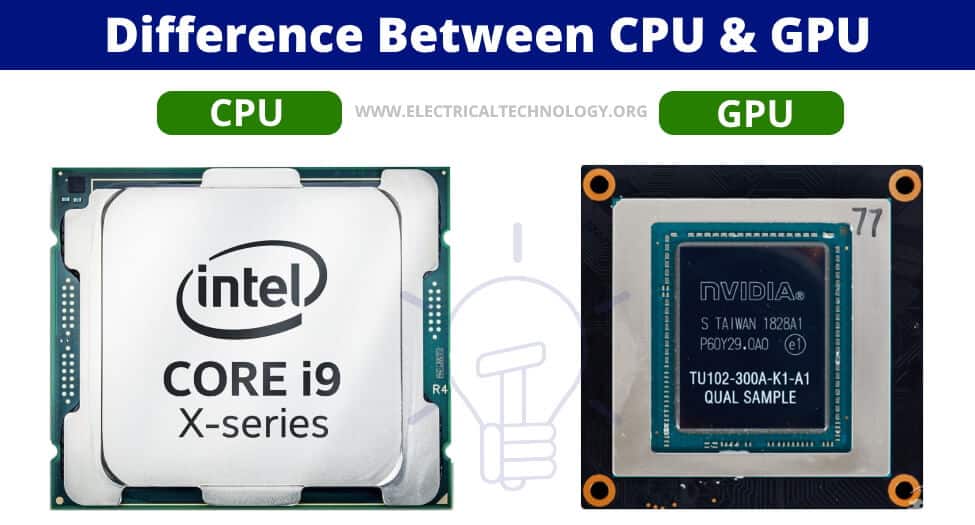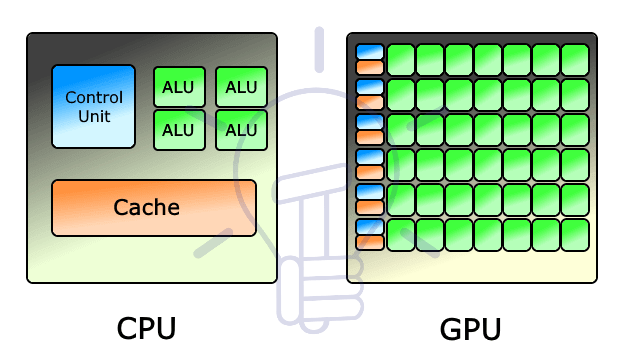Key Difference Between CPU and GPU
The CPU (Central Processing Unit) & GPU (Graphics Processing Unit) have multiple common features such as they are both processors made from millions of semiconductor transistors & they are capable of processing digital using some algorithms. But they are quite different.
In this article, we are going to discuss the differences between CPU & GPU. But before going into that, let’s discuss what CPU & GPU really is.
- Related Post: Difference Between Microprocessor and Microcontroller
What is a CPU (Central Processing Unit) ?
The CPU or the Central Processing Unit is made up of millions of transistors & is commonly referred to as the brain of any computer that is responsible for processing any data. The CPU consists of ALU (arithmetic logical unit), CU (Control Unit) & Memory. The ALU job is to perform any arithmetic or logical operation on the data provided by the memory, and the control unit controls the flow of data.
- Related Post: Difference Between RAM and ROM – Comparison
What is a GPU (Graphics Processing Unit)?
The GPU or Graphic Processing Unit or normally called Graphic or video card is a special purpose microprocessor specifically designed & optimized to process graphical data. It converts the data from one graphic format to another or creates 2D or 3D images called rendering.
The GPU is made of relatively more processing core but they are weaker than the CPU. The cores are a bunch of ALUs designed to execute simple instructions in repetition. Rendering is a simple arithmetic operation that is done over & over again. So it does not need a processor with wide range capabilities but rather a processor with multiple parallel cores with a limited number of instructions.
The benefit of using a large number of cores is to provide high-throughput, execution of multiples instructions at the same time. This is what makes the GPU faster & better than CPU at rendering visual data.
The GPU is best at performing a simple repetitive task intensively, therefore they can be used for simple non-graphical tasks as well such as bitcoin mining & password decoding that relies on huge data that can be processed in parallel.
Main Differences between CPU and GPU
Here are some of the differences between CPU & GPU provided in the form of a table;
| CPU | GPU |
| CPU stands for Central Processing Unit. | GPU stands for Graphics Processing Unit. |
| CPU is a General-purpose processor. | GPU is Special purpose processor. |
| CPU is more flexible with a larger instruction set & can perform a wide range of tasks. | The GPU has limited instruction & capable of only graphics-related tasks. |
| It can generally execute any kind of task including graphics but not in a very optimal way. | While GPU’s sole purpose is to process images & 3d graphics much faster than CPU. |
| The CPU may have a few powerful cores to distribute the workload. | The GPU is made of multiple weaker cores to perform a simple repeated operation. |
| Its processing speed is very high & runs at a very high clock speed of about 3 to 5 GHz but fewer processing cores. | Its runs at a lower clock speed of around 800 MHz but it has hundreds to thousands of processing cores. |
| It requires a more memory RAM as compared to GPU. | It required less RAM as compared to CPU that is why integrated GPU shared the RAM with CPU. |
| The CPU mainly focuses on the low latency (the time delay between instructions & data transfer). | The GPU focuses on maximum throughput (parallelism, number of instruction execution in a time interval). |
| The CPU is optimized for sequential instruction operation. | The GPU is optimized for Parallel instruction operation. |
| CPU concentrates on the computation of any data received. | While the GPU receives the data from CPU & generates the visual images accordingly. |
| It Interacts with multiple computer components such as RAM, ROM, I/O ports to perform instructions. | The GPU only Interacts with the memory & the display unit to decide how to display the pixel on the screen. |
These are some of the differences between the CPU & GPU. The CPU is best for executing a wide variety of tasks quickly & provides the best performance per-core. While the GPU is best suited for simple instruction that needs to be done repeatedly such as the generation of images, 3d rendering & animation.
Both of them may share some similarities but you cannot replace one with the other, they are well distinctive & important at performing their own task. And they work best when they are together on a computer.
Related Posts:
- Difference between Analog and Digital Circuit – Digital vs Analog
- Difference between Inverter & UPS – Uninterruptible Power Supply
- Difference Between Online UPS and Offline UPS – Which One is Better?
- Difference between Electrical and Electronics Engineering
- How to Make and LED Project with ATMega Microcontrollers?
- How to Program PIC18 Microcontroller in C?


 Difference Between GND, 0VDC, Common and Virtual Ground
Difference Between GND, 0VDC, Common and Virtual Ground Is It Dangerous to Carry a Battery in an Elevator?
Is It Dangerous to Carry a Battery in an Elevator? What is the Difference Between AC Ground and DC Ground?
What is the Difference Between AC Ground and DC Ground? Why Doesn’t DC System Require a Grounding System Similar to AC System?
Why Doesn’t DC System Require a Grounding System Similar to AC System? Why Do Americans Use Gas Kettles Instead of Electric Kettles?
Why Do Americans Use Gas Kettles Instead of Electric Kettles? What Will Happen If You Connect a Male-to-Male Plug Between Outlets
What Will Happen If You Connect a Male-to-Male Plug Between Outlets